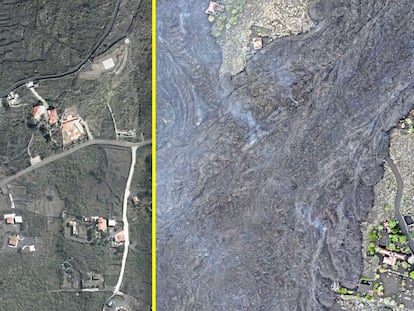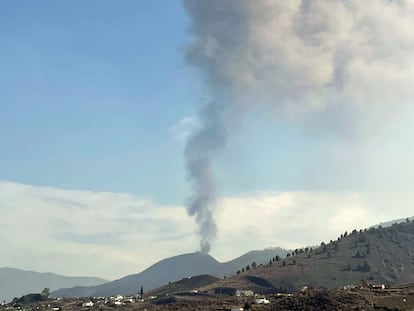On the frontline of La Palma volcanic eruption: ‘It took everything from us’
The fallout from the devastation has brought together victims, psychologists, police officers, rescue workers and politicians in an amazing show of solidarity. These are their stories
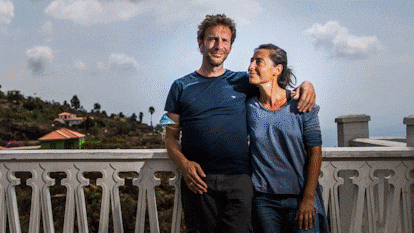

The images of lava flowing from the Cumbre Vieja volcano in La Palma have been broadcast across the world, and will forever remain in the collective imagination of the Canary Islands, a volcanic archipelago located off the northwestern coast of Africa.
On Tuesday morning, the main flow of lava was between 800 and 1,000 meters from the coast of Tazacorte, according to the Volcano Risk Prevention Plan (Pevolca). The tongues of molten rock have picked up speed after new volcanic material began flowing out of the main cone late on Monday.
While spellbinding to watch, the September 19 eruption has destroyed the homes and businesses of more than 500 families and is threatening another 1,600. But it has also created a wave of solidarity among the community and the professionals who are working tirelessly to help the victims. These are their stories.
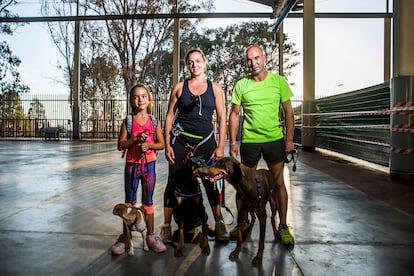
Davinia Viña, victim: “If this is happening, it must be for a good reason... I don’t know”
The 20 dogs rescued from the homes that were either evacuated or destroyed by the river of molten rock bark incessantly inside their cages in the makeshift shelter that the Benawara association has set up in a pavilion in the town of Los Llanos de Aridane in La Palma. Davinia Viña, 39, is there this morning, together with her husband, Adolfo Paíz, 42. Nearby, their nine-year-old daughter, Nilsa, is running around playing with one of their four dogs. The family’s prospects hang in the balance as they wait to see if the lava will engulf the home they have shared for 15 years. “It is very sad to see your family’s house destroyed, and to talk to neighbors who tell you, ‘Mine has already been swallowed up.’ It is sad. Sad, sad, sad, sad....” Davinia sobs. The house – Adolfo’s childhood home – is still standing, but the drama is not yet over. “There are many days left of the volcano,” she adds.
Davinia worked at the Covalle banana cooperative, a few meters from her home; Adolfo, at a local construction company. “I have lost my job for sure,” she says.
Like all the locals in the area, Davinia remembers the afternoon of September 19 in minute detail. “We were having lunch outside our house, and there was talk that the lava was going to come out through Jedey [a neighborhood in El Paso], and suddenly at 3pm everything went boom. And my husband shouted, ‘It blew up!’”
Until that moment, she had begun calculating the length of the intervals between the tremors. “I thought, ‘This is going to be like childbirth.’” With each tremor, the entire house would shake. “The windows, the cabinets, the glasses...” Davinia dissolves into tears as she describes the scenario that prompted her to get together two changes of clothes, the deeds to the house, bottles of water, blankets, two pillows and juice for the couple’s daughter. “It made me feel very emotional,” she says. “I didn’t take anything material, just food and clothes. I didn’t take anything. If the lava needs to take it, let it take it all. If this is happening, it has to be for a good reason... I don’t know.” She becomes too upset to go on.

Jakob Schuster, victim: “I am the luckiest man on earth”
Jakob Schuster, 49, was born in Munich, but has been living in La Palma for five years with his wife Sandra, 47, two dogs and three cats. During the last two years, he has “lovingly” renovated “a tiny little village” – investing almost all his savings into the project. The result was Pueblo Munay, a small rural tourism complex in the neighborhood of El Paraíso, which is rated 9.7 out of 10 on the Booking.com website. “We opened shortly after the pandemic broke out, but we survived Covid because we were smart enough to leave some money in the bank,” he says. “And then the volcano came and took everything from us.”
Schuster strives to put a good face on things outside the Severo Rodríguez sports center in Los Llanos de Aridane. “I don’t want to sound sad or overly whiny,” he says. “Actually, I’m the luckiest person on earth. I have been blessed: we have come out alive from this eruption – my father-in-law, who is seriously disabled, my wife, myself, two dogs and two of my three cats.” In fact, he believes his luck is something to “shout about.” As he says: “You don’t usually survive when a volcano explodes barely 600 meters behind your house.” He stayed with friends in the municipality of Tijarafe for a few days and is now on the Canary Island of Tenerife.
At the time of the eruption, at 3.12pm on Sunday, September 19, Schuster was in the patio of his “tiny village” with two guests to tend to. He claims he received no warning. “We were all completely shocked,” he says. “It was thought it would explode three kilometers away. But I don’t blame anyone and I don’t hold a grudge against anyone. There is only one culprit – the volcano.”
A few hours after this conversation, Schuster was admitted to hospital suffering from an anxiety attack.
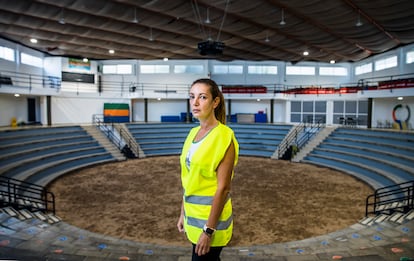
Nayra Rodríguez, psychologist: “There is a feeling of being unmoored”
Nayra Rodríguez, 39, a doctor in psychology who was born in La Palma, feels equally attached to Los Llanos de Aridane and Tazacorte, despite the fact that for the last few years she has been living in Tenerife where she studied for her degree. When the volcano erupted, she left her job and traveled to La Palma. First, she wanted to see how her family was doing. Then she wanted to help the community. Rodríguez is passionate about emergency response and is specialized in the area. “I realized that my personality is suited to stressful situations,” she says. She did not hesitate to immediately join the corps of nine psychologists who spend their days at the Severo Rodríguez sports center, a facility that has become the logistical center for the reception and distribution of aid and assistance to the victims.
“Some people react with great sadness in emergencies and others suffer an emotional block, or even deny the circumstances and prefer to pretend they are in a movie and that it doesn’t involve them,” she says, adding that shock and anxiety have been the most common reactions to the eruption.
When it comes to the local character of La Palma’s inhabitants, she says: “We are very close and warm. We might be suspicious at first, but when we gain confidence, people from outside are treated like family. Compared to other emergencies and catastrophes, in which it is impossible to predict how people will react, I would like to flag up the calm and solidarity that has been shown by the people of La Palma. And not only from the economic point of view,” she adds. “People have lost everything, not only their homes. They have ceased to have a reference. Imagine being from a place and having nowhere to go. There is a feeling of being unmoored on the island.”
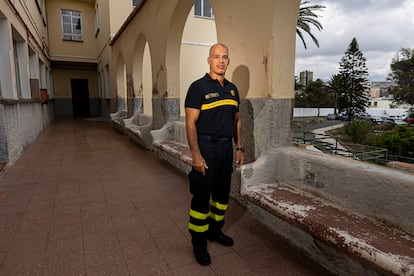
Mario Beltrán, firefighter: “We are going to fight and keep fighting until the end”
Mario Beltrán, 55, is head of operations at the headquarters of the Gran Canaria Firefighters. He leads the team of 18 professionals that arrived on La Palma at 1am on Monday, September 20, with four trucks and three light vehicles, just eight hours after the eruption. “I had an operation already designed for different scenarios,” he explains to EL PAÍS by phone.
The team forewent beds at the Santa Cruz de La Palma hotel, preferring to sleep “10 minutes from ground zero” in a pavilion. Beltrán says he has nothing but admiration for the islanders. “The people of the island are patient and have incredible resilience, apart from being very well-mannered,” he says. “Congratulations to them, really.”
Contrary to expectations, Beltrán and his team have not had to put out any fires. “This volcano has taught us all a lesson,” he says. “It has caught us all on the wrong foot.” The firefighters have, however, been called upon to carry out many other tasks, such as saving animals, helping with evacuations and even digging ditches to try to divert the lava flow and prevent it from reaching the Todoque village square and church bell tower. “Many couples met at that square and got married in that church,” he says, clearly moved. “That was a move that had no guaranteed outcome. But even if it was in vain [the church collapsed on September 26], it was important to have tried to pull it off, both for the team and for the locals. We are going to fight and keep fighting until the end.”
Like everyone, Beltrán has been affected by what he has seen. “The most important thing for a firefighter is the protection of people and property,” he says. “And that’s why everything that has happened has had an emotional impact. This Saturday [September 25] we carried out an inspection, and when you see all those houses with only a few hours left standing, and you know what that means to someone... It’s hard, very hard.”
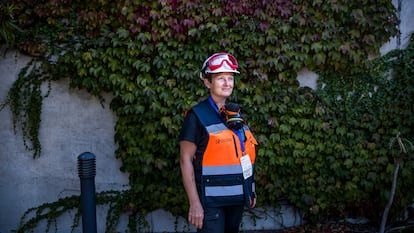
Inés Galindo, volcano expert: “At least I realize that what I’ve done all my life is helping people”
The volcano eruption in La Palma has been a sort of baptism by fire for volcanologist Inés Galindo, 48. It is the first time she has been on the frontline of an erupting volcano. “I have been to another one in Costa Rica, but at a distance,” she laughs. She was also at the underwater eruption on El Hierro – the smallest of the Canary Islands – 10 years ago. “But that was nothing like this.” With a degree in geology from the University of Zaragoza and a PhD from the University of Barcelona, she is trying to predict how this volcano will behave.
Her passion for geology and volcanoes started when she was a child, after TV footage showed the effects of the Nevado del Ruiz volcano, which killed 13-year-old Omayra Sánchez in the Andes mountains in Colombia. “Although I am from Gran Canaria, Lanzarote has always been my favorite island,” she says. This, of course, is because of Timanfaya Natural Park, which is the result of volcanic eruptions several centuries ago. But while she is fascinated by volcanos, she is also passionate about helping their victims. “I like eruptions, but also helping people who may be affected by them,” she explains from a bench outside the command center on the slopes of the Caldera de Taburiente National Park in La Palma.
“As far as I’m concerned, this is not a satisfying scenario, because you’re watching the suffering of many people who have lost everything. But at least I realize that what I’ve done all my life is helping people.”
She does, however, feel that more investment should be made in volcanology. “The real problem is that there are few studies on historical eruptions, because there is no funding for the research,” she says. “It’s downplayed because it’s not very likely, until there’s an eruption.”
Within this context, the past week has been a continuous learning process for Inés. “I’m learning a lot every day, but you’re always left with the nagging feeling that it would have been better if nothing had happened.”
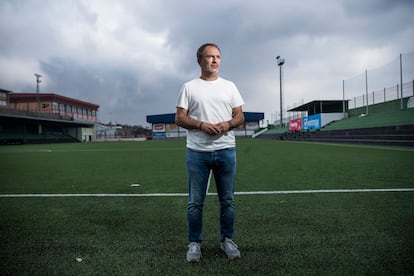
Sergio Rodríguez, mayor of El Paso: “It hurts me so much because we are an unassuming people”
The life of Sergio Rodríguez, 52, could have gone many different ways. Born in El Paso, he went to Tenerife to study English Philology and lived on the neighboring island for 22 years before returning to his hometown. “I’ve never actually managed to leave,” he says, “I’ve always been attached to this place.”
When he returned, he got into politics. “My father was a member of the city council when I was small. It was another era, during the transition [from the Franco dictatorship to democracy], so you could say it’s been part of my life since I was a child.”
He is halfway into his second term representing the Coalición Canaria party. He leads the local government with an absolute majority of nine of the 13 elected council members, up from six during his previous mandate. Yet the last few months have been “by far” the most difficult of his political career. “First there was the wildfire in August – the second I have experienced as mayor,” he says. The fire caused hundreds to be evacuated and ended up affecting 300 hectares of both El Paso and neighboring Los Llanos de Aridane, causing extensive damage. “And now this, which has no comparison.”
That said, Rodríguez has remained calm during one of the most difficult weeks in the small municipality of 7,500. “I am hyperactive,” he says. “If you saw me in my day-to-day life, you would see that I can’t stand still. But it’s in these crisis situations that I am at my calmest – I don’t know why.”
His state of mind is, he admits, partly due to support from his fellow citizens. “We are above all a rural municipality. And the people here are fighters, hard workers,” he explains from the local soccer field, which has acted as a meeting point for those evacuated and to distribute food. “That’s why what is happening hurts me so much. Our people don’t have a lot of money; we are unassuming people, who have earned it. We are supportive and look out for our neighbors. And everyone else; long-suffering people who put in a lot of hard work.”

Pedro Cuesta, chief inspector in the National Police: “This is an unfamiliar situation for all of us”
The face of chief inspector Pedro Cuesta, 41, is tense. He is stationed at a crossroads on the LP-215 road, surrounded by a dozen colleagues. It is Tuesday, September 21. Two days have passed since the volcano erupted and the 10th Police Intervention Unit (UIP) that he coordinates has to supervise the residents of the already evacuated neighborhoods of Puerto Naos and La Bombilla in Los Llanos de Aridane as they enter their homes for a few minutes, making sure they leave in an orderly manner. “We are having to deal with a situation unfamiliar to all of us, both for the emergency services and for the National Police,” he explains. “Nevertheless, the behavior of the people of La Palma is exemplary.”
Cuesta was born in Fuenteálamo in Albacete, Castilla-La Mancha. He studied law at the University of Valencia and graduated in police sciences at the University of Salamanca, then chose to kick off his career in Las Palmas, the capital of Gran Canaria, a completely different environment from the Castilian plateau. “I was young and the Canary Islands were a place I didn’t know. I came here looking for a new experience and, in the end, I settled here. The Canary Islands offer personal quality of life and professional challenges,” he says, adding that he did spend some time in Pamplona before putting down roots in Tenerife.
He arrived on La Palma on September 19, at 11pm by boat. And he plans to stay for as long as it takes to deal with the situation. “As long as we are needed, we are not going anywhere,” he says. His daily work at the head of the 41 members of the UIP on the island entails visiting the command center, coordinating with other services, especially with the 270 agents of the Civil Guard, and preventing access to prohibited points and areas.
But, above all, he and his team are there to lend the locals a hand. “Unfortunately, in this corps, you often have to witness dramatic and difficult situations,” he says. “It’s difficult to see people running to get the basics in order not to lose everything. And it’s even harder to inform these people that their houses have been destroyed. At the end of the day, we are people too, even if we wear uniforms.”
English version by Heather Galloway.
Tu suscripción se está usando en otro dispositivo
¿Quieres añadir otro usuario a tu suscripción?
Si continúas leyendo en este dispositivo, no se podrá leer en el otro.
FlechaTu suscripción se está usando en otro dispositivo y solo puedes acceder a EL PAÍS desde un dispositivo a la vez.
Si quieres compartir tu cuenta, cambia tu suscripción a la modalidad Premium, así podrás añadir otro usuario. Cada uno accederá con su propia cuenta de email, lo que os permitirá personalizar vuestra experiencia en EL PAÍS.
¿Tienes una suscripción de empresa? Accede aquí para contratar más cuentas.
En el caso de no saber quién está usando tu cuenta, te recomendamos cambiar tu contraseña aquí.
Si decides continuar compartiendo tu cuenta, este mensaje se mostrará en tu dispositivo y en el de la otra persona que está usando tu cuenta de forma indefinida, afectando a tu experiencia de lectura. Puedes consultar aquí los términos y condiciones de la suscripción digital.
More information
Últimas noticias
Most viewed
- Reinhard Genzel, Nobel laureate in physics: ‘One-minute videos will never give you the truth’
- Oona Chaplin: ‘I told James Cameron that I was living in a treehouse and starting a permaculture project with a friend’
- Pablo Escobar’s hippos: A serious environmental problem, 40 years on
- Why we lost the habit of sleeping in two segments and how that changed our sense of time
- Charles Dubouloz, mountaineering star, retires at 36 with a farewell tour inspired by Walter Bonatti
